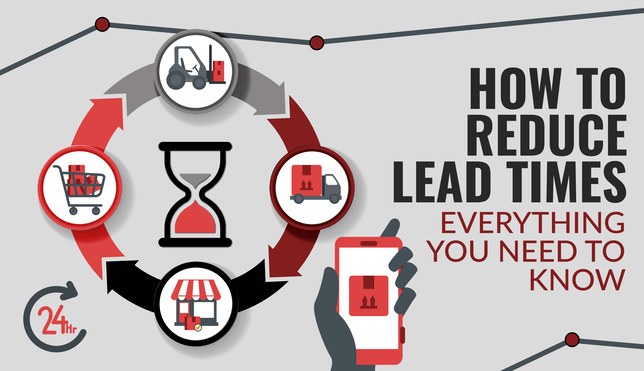If you’re looking for ways to reduce lead times, you’re in the right place. In this post, you’ll find 11 effective strategies manufactures can use to help reduce lead times in the warehouse.
Plus, we’ll go through some common lead time questions.
Let’s dive in!
Find Diversified Suppliers
Working with a variety of suppliers has a few benefits, including:
- Fewer late shipments
- Fewer product quality issues
- Better communicated lead times
And each of these benefits helps endear your brand to your customers. Plus, they can help shorten your lead times.

Diversified suppliers with quality supply practices achieve better performance in quality, flexibility, reliability, cost, and design.
But just a word of warning…
If you decide to make changes, ensure your inventory management keeps you stocked enough to get through the changeover period. This will help avoid inventory deficits and help you get up and running with a new supplier more quickly.
Tip: Many industries have been hit hard by the pandemic and believe it or not some still have not caught up yet today. If you’ve been working with a supplier for many years, it may be more beneficial to stick with that supplier if the sole reason for wanting to change is because of lead times. Eventually, the supply chain will normalize and the trustworthy supplier you’ve been working with will be there.
Choose Domestic Suppliers

The closer the supplier is to your warehouse, manufacturing plant, or location, the easier it is to reduce lead times.
Although there can be a temptation to “chase” the best prices to far-flung places, a local/domestic supplier is a great choice to reduce lead times.
The common problems with outsourcing overseas include:
- Increased wait times to receive shipments – in some cases 30 to 40 days.
- Language barrier.
- Complicated return process.
Closer suppliers can benefit you in many ways, including:
- Reduce lead times, which is equal to reduced shipping times.
- Better ROI from faster order fulfillment.
- Easier returns.
- Avoid expensive international tariffs.
- Avoid delays associated with customs holdups.
Note: If you can’t find a local supplier, use the large ordering strategy: Placing larger orders but less frequently to keep more inventory on hand.
Consolidate Suppliers
Managing lead times demands more than just managing your suppliers.

The problems associated with handling multiple suppliers include:
- Spending more time coordinating and handling multiple vendor accounts.
- Taking time to implement setup and vendor management software.
- Handling multiple purchase orders.
- Managing multiple supplier relationships.
These activities almost always strain your lead time.
Although it’s common to have at least one backup supplier to avoid complete dependence on one source, it’s unlikely you’d need multiple backup suppliers.
So, consider condensing your suppliers and eliminating redundant suppliers. Have one backup supplier and not more than two to reduce the time spent handling multiple accounts.
Improve Internal Communication
A supply chain process in any operation involves multiple steps and many people. And if it’s a paper-based system, it’s prone to errors. These are avenues of communication problems that can precipitate lead time issues and delays in supply.
If your supply chain process demonstrates numerous communication problems, they’re symptoms of deeper issues that must be resolved.
To solve the communication issues, implement an automated workflow system. This will route order documents from department to department and immediately notify key users when action is required.
Improve External Communication
Effective communication comes with opportunities, but poor communication comes with challenges.

The problem(s) associated with lack of or inadequate communication with suppliers include:
- More time spent communicating with and reacting to unfavorable situations.
- More stress due to unmet expectations.
- Difficult and long process to build confidence in suppliers. It’s also easy to lose confidence instantly.
You can overcome problems like miscommunication and miscoordination through a proper communication flow.
When miscommunication with suppliers occurs frequently, it can slow down your production process.
Constant communication with suppliers helps ensure smooth process flow and keeps expectations met. This also helps address any issues along the way promptly.
When communicating with suppliers:
- Share your demand/sales forecasts with them to let them know when to expect reorders. This is important in industries that naturally fluctuate. Suppliers will know when to expect an increase in demand.
- Provide key performance indicators to motivate the supplier to achieve your expected service levels.
Communicating with customers may not directly help reduce lead time but can help set expectations and increase satisfaction.
You can also use a shared automated workflow system with the supplier to send order update notifications via email or text or to notify the supplier through the system.
Motivate Employees
If you trace bottlenecks to your production or team, consider your employees’ level of motivation.
Demotivated employees can sometimes cause lead time delays directly or indirectly. Ask questions like:
- Do employees have a clear direction?
- Do employees understand the metrics behind the success of their department?
- Do they get enough rest time or off-work schedules?
Motivating your employees with cash bonuses, gift cards, lunches, and time off from work can improve their job satisfaction. This will result in improved performance and reduced lead times.
Bring External Processes In-House
Should you outsource or bring it in-house?
Outsourcing certain aspects of your production process sometimes can leave you at the mercy of your partners. Thus this lack of control can increase lead times and leave you without many solutions.

Solution: Bring all production tasks in-house to avoid any unexpected delays.
In-house management and delivery operations give you:
- Reduced expenses on third parties and production lead time reductions.
- Full control over your customer service and lead time management.
- Access to all your data about customer deliveries with granular detail to make informed decisions quickly about your logistics management.
- More flexibility in decision-making and quickly acting on them. With data and full control, you can change, adjust, and pivot as needed.
The result: You’ll have long-term savings and scale with growth more easily since you already have the infrastructure.
However, bringing external processes in-house requires significant investment. You’ll need to have your warehouses, a fleet of delivery vehicles with drivers, and proper management and planning, including staff.
Increase Capacity
One of the reasons you’re having an increased lead time could be your production capacity.
Can your infrastructure, production lines, machinery, equipment, material handling vehicles, and software systems (e.g. WMS) keep up? If they’re inadequate, you may have increased lead times.
Solution: Increase your capacity
Update your production tools, resources, and technology, and use automation equipment such as conveyors and AGVs, to improve your capacity.
Use Standard Components
You can choose to customize your production/delivery or use standard processes: Custom vs. standard manufacturing.
If you must use a customized solution, rely on a specialized supplier who won’t be learning on the go.
Lead times tend to be longer for custom manufacturing because of the increased processes and resource demands. Unless specified by the customer, use standard manufacturing.
But don’t compromise the production performance or quality of finished products because you may risk poor quality and customer dissatisfaction.

You can collaborate with designers to tweak designs to allow for standard components when possible.
The advantages of using standard components are:
- Save time in engineering and production.
- Reduce costs.
- Outsource cumbersome processes.
While bringing processes in-house gives you control of your lead time, you may not own all the processes.
Just as outsourcing can slow you down, producing items outside your expertise or unlimited resources can slow you down. If you don’t specialize, reconsider whether doing it yourself is beneficial.
If you don’t have the expertise or capacity to do it yourself, consider outsourcing.
For example, if you’re handling warehousing yourself, consider switching to a public/3PL warehouse that provides receiving, storage, order fulfillment, shipping methods, and even value-added services like kitting.
This will let you focus on what you do best as you leave specialized tasks to specialists.
Use Automation Software
You can reduce lead times by automating inventory management, order entry, order processing, and other workflows.
Generally, manual order processing has a big impact on lead times, including:
- Takes longer to enter new purchase orders.
- More time to process order changes.
- Miscommunication.
- Errors in orders.
- Lost orders because of manual entry errors.
You can use system automation (automation software) to replace manual entry.
Automation has many benefits, including:
- Eliminate human error in manual processes.
- Faster order processing.
- Keep your workflow moving smoothly.
- Create better order tracking, data, and reporting metrics to help you understand your business and predict more accurate lead times.
- Convert purchase orders into sales orders automatically.
- Reduce pricing discrepancies.
- Real-time order transparency.
To get started, consider the tools you already use, such as your ERP system, and find the automation capabilities you already have access to but are not utilizing.
Also, consider other internal workflows because lead time might not be the only area in your business that can benefit from automation.
Upgrade to full automation in these other areas gradually and use the tools to improve your performance and reduce lead times.
Identify and Eliminate Bottlenecks
Finally, to reduce your lead times, you must identify inefficiencies in your organization and within your internal processes. You’ll reduce lead times by improving efficiency and accountability.

To identify these inefficiencies in internal operations, break each step into smaller steps, then determine the best way to deal with them.
Common internal problems/bottlenecks are:
- Running processes in series. You’ll waste time doing things one after another instead of producing simultaneously.
- Multiple hand-offs between departments. You risk errors and delays every time something changes hands.
- Wasted trips due to commonly-used components not being close to work areas. For example, if an assembly is required, not keeping all the components close to the assembly station will lead to time wasted transporting them to the station.
- Machine breakdown or changeover.
Solutions to these bottlenecks are:
- Run processes in parallel. If processes can run simultaneously, do so as much as possible, and you’ll be saving hundreds of hours in the long run.
- Consolidate tasks under a single department. Workflow within departments is easier than workflows across different departments.
- Reduce parts gathering by grouping components frequently used together. This improves work organization and makes picking/assembly easier.
- Perform preventive and scheduled maintenance on machines to prevent machine downtime.
Lead Time FAQs
Let’s go through some frequently asked questions about lead time.
What Does Lead Time Mean?
Lead time is the time or duration between when a product/item order is placed and when it’s ready for shipping. In some businesses, this is called processing or handling.
What Is Lead Time in Manufacturing?
Manufacturing lead time is the time between when the manufacturing order comes in and when it’s completed and ready for delivery to a customer. In manufacturing, lead time does not include shipping time.

Here’s a manufacturer lead time example: If a furniture manufacturing company has a 21-day lead time for custom office chairs, it means the chairs will be ready to be delivered to the customer 21 days from the purchase order date.
What Is Lead Time in Supply Chain?
Supply chain lead time refers to the time between when a supplier receives a purchase order (from a wholesaler or individual) and when the goods are delivered to the customer. In this context, lead time includes shipping time.
Here’s a supply chain lead time example: If a furniture supplier receives an order for office chairs, the lead time is the period between when the order arrives and when the customer receives the goods.
Lead time can be hours, days, weeks, or months depending on the nature of the product and its demand.
Why Is Lead Time Important?
Customers don’t like to wait. They expect to receive their orders quickly, if not immediately. Businesses/manufacturers use lead times to calculate how quickly customers can get the products they order.

Longer lead times mean waiting, which translates to customer frustration and dissatisfaction. Shorter lead times can translate to a strong competitive advantage. More people will order from you because they can get the goods they want faster.
What Are the Top Lead Time Reduction Benefits?
Lead time reduction includes all measures to minimize the time orders take from the manufacturing facility to the merchant or customer. The top lead time reduction savings or benefits include:
- Faster order processing to meet deadlines consistently.
- Increase customer satisfaction.
- Improve cash flow.
- Reduce waste.
- Streamlining operations.
- Optimize productivity.
- Improved flexibility during rapid market shifts.
- Quicker stock replenishment.
Why Is Reducing Lead Time Important?
Reducing lead time can help a manufacturer/supplier streamline operations and improve general productivity, resulting in increased output, revenue, and customer satisfaction.
In contrast, longer lead times can negatively affect the businesses’ manufacturing process and overall sales. This is why reducing lead time helps mitigate the consequences of long lead times, such as:
- Running out of inventory.
- Costs money in terms of lost orders.
- Carrying more inventory to compensate for unreliable suppliers.
- Compromised speed to market. If you have high lead times, your competitors introduce new products more quickly.
- Less market share.
- Difficulty in responding to market changes because of less time to react.
- Inadequate quality control issues.
- Loss of customers. If your competitors’ lead times are shorter than yours, customers will go to your competitors because they can get their orders faster.
Reducing lead time also enhances inventory management, resulting in fewer lost sales, reduced carrying costs, and improved customer and supplier relationships. Shorter lead times mean suppliers or resellers can order according to market fluctuations without worrying about long waits for stock to arrive.
What Is Manufacturer Standard Lead Time?
Put simply, the manufacturer standard lead time is the period between when a manufacturing order comes in and when the product’s manufacturing is completed.
Manufacturers prefer to keep a shorter manufacturer lead time than a longer one because it ensures quicker product delivery to merchants/customers.
When Does Lead Time End?
Lead time ends when the manufacturer completes production and is ready for shipping.

If the purchase order was made to an outlet, lead time ends when the outlet has received the goods and is ready to ship them to the customer (reseller, wholesaler, individual).
Does Lead Time Include Shipping?
Some types of lead time include shipping. For example, order or supply chain lead time includes shipping time, but manufacturing lead time doesn’t.
Order lead time includes the time it takes to prepare the product for delivery and its shipping time while en route to the customer.
In contrast, manufacturing lead time doesn’t include shipping. It’s only the time taken to prepare or manufacture an item to be ready for delivery.
What Is the Difference Between Lead Time and Turnaround?
Lead time is the time gap, defined by the supplier or manufacturer, between when a customer places an order and when the product is ready for delivery (or the customer receives the product).
In contrast, turnaround time (TAT) is the time spent to prepare, produce, or manufacture a product and deliver the output according to the customer’s request. It’s the time gap from the moment of a processing request in the order processing center to its completion.
What Is the Difference Between Customer Response Time and Lead Time?
Customer response time (CRT) is the time between when the customer places an order and when the manufacturing process. This is the total time between when the customer order is received and when the manufacturing team starts working on the product.
In contrast, lead time is the sum of time the manufacturer/supplier promises to process the order, such as converting raw material to finished goods and the order’s waiting time at the buffers.
What Is the Difference Between Lead Time and Cycle Time?
Lead time begins when the customer places an order, the manufacturer acknowledges it, when the product is ready for delivery, or when the customer receives the product. Cycle time is the number of days (calendar days) it takes to complete a particular production/manufacturing task, or cycle, once the work starts, from start to finish.
Cycle time is used to measure the production’s work in progress. Furthermore, it shows that cycle time resides within lead time and indicates the “work-in-progress” time to create an order and produce something.
What Are the Types of Lead Times?
Types of lead times differ based on the context, product, or customer.
Customer-Oriented Lead Times
Types of lead times focused on meeting customer needs:
- Order lead time. What is order lead time? Also called “supply chain lead time” (or “supplier lead time”), order lead time is the time between when a customer places a purchase order and when the customer receives the goods.
- Customer lead time. This is the amount of time it takes to fulfill a customer’s order. It is the time ranging between when a customer orders goods (from a supplier, store, or salesperson) and when the goods are delivered to the customer.
- Delivery lead time. This is the minimum time, in calendar days, from when a product’s processing/production is complete until it’s delivered to the customer. If “delivery time” refers to the actual product delivery time after it’s ready for shipment, then it’s the same as delivery lead time. But if it’s used to refer to how long it takes to place an order and receive the product, then that’s the order lead time.
Supply Chain-Oriented Lead Times
Types of lead times focused on supply chain management:
- Production lead time. This is the period between when a manufacturing order comes in and when the product’s manufacturing is completed and ready to ship. It is also called “manufacturer lead time” or “factory lead time.”
- Purchasing lead time. Also called “purchase order lead time” (POLT), this refers to delivery lead time. Except, POLT is often used when handling formal purchase orders or when a company is purchasing production raw materials.
- Procurement lead times. Lead time in procurement refers to supply time, i.e., the total time it takes to receive the raw materials or basic items needed to make the finished product. Procurement lead time includes identifying a procurement need, selecting a good/service, sourcing vendors, negotiating, ordering the product, and paying. Also, procurement lead time includes purchasing and its lead time and is often measured in months.
- Material lead time. This is the time a supplier takes to deliver materials to a customer immediately after the initial order is placed.
- Cumulative lead time. This is the total amount of time it takes a factory/manufacturer to manufacture a product from beginning to finish, including procurement of raw materials and subassembly of related units.
- Inventory lead time.This is the time it takes to prepare a product for shipping, deliver it, order a stock replacement, and receive the new stock in the inventory. Effective inventory management helps minimize this lead time.
- Shipping lead time. Lead time in shipping refers to how long it takes to prepare a product to be ready for shipping after an order is received. This includes the order’s processing time and the time spent delivering it. In contrast, shipping time means the time it takes for an item to be delivered from a warehouse/manufacturing site to the customer.
In supply chain management, understanding these different lead times is crucial for optimizing operations and ensuring timely delivery of products.
What Factors Affect Lead Time?
The factors that can affect lead time are:
- Suppliers. Reliable suppliers will give you shorter lead times because of their improved response time, order processing, and shipping. Use reliable suppliers and ditch unreliable ones.
- Unnecessary or lengthy process. Sometimes lead times can increase due to lengthy or unnecessary assembly or order processing. This can reduce order completion time and lower the output. Optimizing processes can help reduce unnecessary movements and save hours in handling and delivery.
- Stockouts or lack of raw materials. Unreliable suppliers can cause stockouts, which can cause a delay in the entire supply chain including production and delivery lead times.
- Geographic location. Being too far from suppliers, such as ordering from overseas, can cause long lead times. This can be due to numerous unforeseen risks such as border issues, import duty, tax, shipping/transport breakdown, etc. It’s best to use local suppliers to attain short lead times.
- Inefficient inventory control. Lead times are adversely affected when you have inefficient inventory control. It’s best to use automated inventory control to eliminate inefficiencies such as human error and lack of tracking.
- Shipping delays. This is the most difficult and unpredictable issue to control. Shipping delays can result in longer lead times due to increased transportation time from natural disasters or human error. Sourcing from local suppliers can help reduce the risk of shipping delays.
- Communication and lead time variability. Lack of or inefficient internal and external communication can adversely affect lead times. When there’s poor communication, misinformation and misunderstanding may occur, affecting lead times. To solve the communication issues, implement an automated workflow system to facilitate internal and external communication.
How Does Lead Time Affect Cost?
Lead time has a multiplier effect on costs. Longer lead time ties up cash in large inventories, which could be used to price products more competitively or get more sales. Increased storage time due to longer product holding also contributes to higher carrying costs. Lead time optimization helps eliminate or reduce these costs and improve your revenue.
How Does Lead Time Affect Inventory Levels?
The lead time directly affects total inventory levels at any time: Long lead times cause higher in-transit and on-hand inventory, which affects warehouse management.
The longer the lead time, the more stock you’ll need to hold in your inventory so that you can fulfill your order demands before the next restocking. Also, longer lead times cause unpredictable deliveries, impacting inventory management and forcing businesses to rely on demand forecasts when making orders.
How Does Lead Time Affect Supply Chain Performance?
Long lead times limit a business’s supply chain response to changing demand, uncertainties, and variability. Uncertain lead times in the supply chain can result in increased inventory costs and unstable service delivery or levels, directly affecting the overall supply chain performance.
Furthermore, extended lead time in logistics can result in a halt in the production of the products due to the lack of components needed for production, which can delay delivery and affect the supply chain.

